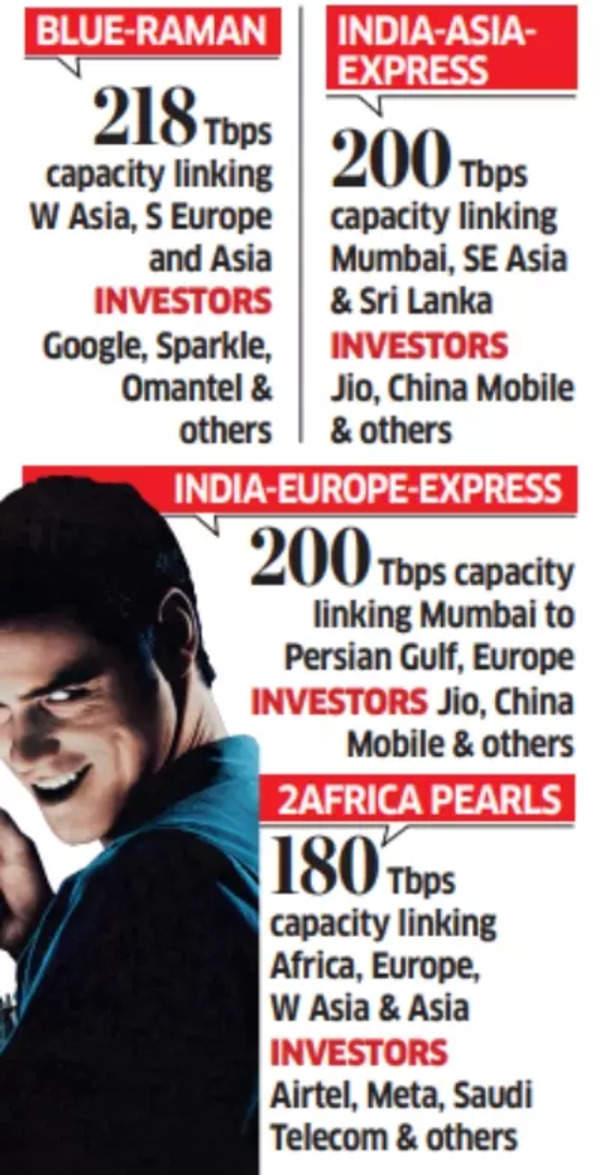Global tech giants Google and Meta are making substantial investments in submarine fibre cables connecting to India. This strategic move positions them in direct competition with established domestic data providers Reliance Jio, Bharti Airtel and Tata Communications during a period of significant data centre expansion.
Industry experts indicate that neutral infrastructure providers like Sify Technologies and Lightstorm are gaining prominence by offering more cost-effective landing facilities compared to established telecom operators Airtel and Tata Communications.
Sources familiar with the project told ET that Google plans to launch its Blue-Raman Submarine Cable System in Mumbai during the first quarter of 2025.
The Blue and Raman project, valued at $400 million with 218-Tbps capacity, includes investment from Italian firm Sparkle. This addition brings Google’s global subsea cable investments to 18.

Global submarine fibre cable projects
Meta’s plans include developing a substantial subsea cable with 500-Tbps capacity, requiring $10 billion in investment over three years. India, being a crucial market for consumer and enterprise AI, features prominently in Meta’s cable routing strategy.
Also Read | High-speed 280 kmph trains soon! Indian Railways to manufacture bullet trains – check top features
“The subsea industry is seeing a major resurgence – 107 new cables were built during 2016-20, representing $13.8 billion in value, with another $18 billion in subsea cable investments underway from 2021 to 2025,” said Vinay Nagpal, chief executive of InterGlobix LLC, a US-based consulting and advisory firm specialising in subsea networks. “India clearly stands at a vantage point to seize those opportunities.”
Sources close to the matter indicate Meta’s cable might connect either in Gujarat, where its partner Reliance Industries is constructing India’s largest AI data centre at 1 Gigawatt, or in Chennai, where Reliance’s joint venture already operates a data centre.
A landing station serves as a compact data centre facility linking submarine cable networks to land-based infrastructure.
Between October and March next year, Jio and Airtel plan to launch three major submarine cable initiatives – 2Africa Pearls, India-Asia-Express (IAX) and India-Europe-Express (IEX) – which will increase current capacity by more than fourfold.
The competition centres on India’s profitable market for undersea optical fibre pairs that enable global high-speed data transmission. Whilst Airtel and Tata Communications currently lead this sector, Jio, despite being relatively new, is actively pursuing opportunities amidst growing data demands.
Also Read | This billionaire American CEO thinks you may work just 3.5 days a week in future
Trai reports indicate the global submarine communications cables market is projected to grow from $27.57 billion in 2023 to $40.58 billion by 2028, with a 7.2% annual increase. Within Asia Pacific, India’s market shows the strongest growth trajectory, expected to reach $78.6 million by 2030. This growth is driven by rising data sovereignty requirements, security considerations, and increasing data centre operations within India.
Government regulations restrict submarine cable operations in India to specific entities. Only those holding international long distance (ILD) and internet service provider (ISP)-A telecom licences are authorised to manage and operate cable landing stations (CLS).




